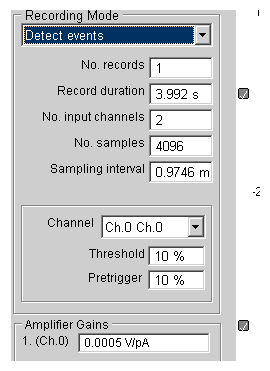Recording Experimental Signals > Recording Modes > Detect Events
 The Detect Events event detector mode provides a means of detecting signals as they occur within an incoming analog signal. A threshold-based event detection algorithm monitors the incoming signal on one of the input channels. An event is detected when the signal deviates by more than a predetermined level from the average baseline level. To compensate for slow drifts in the baseline level, the threshold level is maintained at a constant distance from the baseline by means of a running average calculation. The event detector is configured by setting three parameters.
The Detect Events event detector mode provides a means of detecting signals as they occur within an incoming analog signal. A threshold-based event detection algorithm monitors the incoming signal on one of the input channels. An event is detected when the signal deviates by more than a predetermined level from the average baseline level. To compensate for slow drifts in the baseline level, the threshold level is maintained at a constant distance from the baseline by means of a running average calculation. The event detector is configured by setting three parameters.
If more than one channel is being recorded, select the input channel on which events are to be detected from the detection Channel list.
Enter the detection threshold into the Threshold box. The threshold level is expressed as a percentage of the total input range, with its polarity determining whether positive- or negative-going signals are to be detected. The level should be set as small as possible to maximise the likelihood of an event being detected, but without producing an excessive number of false events due to background noise triggering the detector. Values of around 5-10% are often used, but several trials may be necessary before the best level for a particular experiment is found.
The Pretrigger setting determines the percentage of the record to be collected before the detection point. A typical value is 30%.